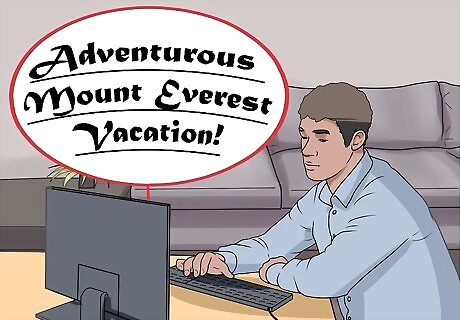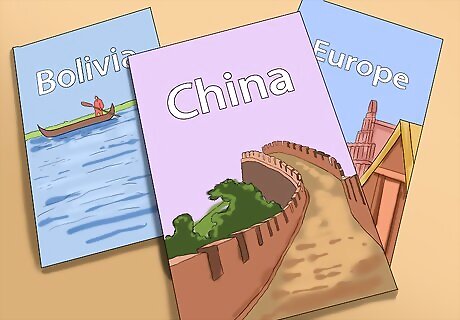
views
Understanding the Job Requirements

Be aware of the low pay of a travel writer. You may have fantasies of being sent around the world on assignments with a big commission, all your expenses paid, and endless days people watching in a European cafe. In fact, very few publications pay a travel writer’s expenses, especially if the travel writer is a freelancer and not a staff member for the publication. Many travel writers work for themselves as freelancers and work contract by contract, story by story. This means you may not have a steady income from travel writing and it can be difficult to make a high income when you are commissioned to write for a publication. Currently, rates for a 500-word article can range from $10 to $1,000. Often, seasoned writers with years of experience writing for big print publications will earn the higher end of the spectrum for one article. Many travel writers do not earn more than $25 - $300 an article. If you are able to land a big feature or a cover story, you will be paid more. However, it can be difficult to land the more lucrative stories and you will often have to write many articles on a regular basis to support yourself financially in this career.

Understand the difficulty of finding a full time position. Landing a full time job as a travel writer for a major travel publication requires years of experience and can be hard to come by even when you do build up a solid reputation in the industry. Many print publications are cutting back on staff as writing moves to online platforms. Instead, you will need to be willing to freelance as a writer as you build up your portfolio. This means you will have to pitch articles to multiple publications on a consistent basis and write many articles for very little pay, perhaps for several years. As a freelancer, you will also need to arrange your own travel accommodations, your itinerary and spend several days traveling on your own. To make travel writing your full time job, you will need to build up contacts and credentials in the industry. This can take several years of working from contract to contract until you make a name for yourself. Many travel writers work other, more sustainable jobs while they travel write on the side.

Remember the benefits of being a travel writer. With the low pay and unstable job security, it can be daunting to pursue a career in travel writing. But many travel writers take on this career because it allows them to experience places they have never seen before and to meet people they would have never met if they were not writing a story about a certain place or area. Often, travel writers are very passionate about their jobs and enjoy the sense of adventure and excitement that their career offers. It’s important that you are a curious and perceptive traveller who is comfortable roughing it when you have to. You should also be willing to pitch your ideas to an editor and be prepared to promote your work whenever possible. As a beginning travel writer, you will need to showcase writing talent and a zest for adventure, as well as an ability to sell your ideas and writing to editors.
Finding Your Niche in the Market

Read texts by successful travel writers in several genres. Today, travel writing is much more than publishing articles in a magazine or in a newspaper. Writers are publishing articles on blogs, online magazines, and other online platforms. Successful travel writers have found a certain niche, or angle, and ran with it, using their unique perspective to keep readers engaged and sell stories to editors. You should familiarize yourself with the market by reading several successful travel writers and bloggers, including: Travel writer Bill Bryson: Bryson is one of the most successful travel writers in the genre and is well respected in England for his travel book on English life, Notes on a Small Island, as well as his American travel book, The Lost Continent".Bryson is known for his dry and witty writing, and often combines memoir and travel writing in his work. Travel writer Kate Adie: Adie is a former BBC chief correspondent who covered war zones in the 1980s across the world. She has written an autobiographical book about her travels in dangerous places called The Kindness of Strangers that is popular among travel writers. Adie’s writing is characterized by dry humor, a knack for finding the absurd in a situation, and a strong grasp on travelling to foreign and often dangerous destinations. The Lazy Travelers Blog: This blog, started by two American best friends, recently won Best Travel Weblog at the 2014 Bloggies. Characterized by the tagline “conquering the globe one glass of wine at a time”, the bloggers explore local and overseas destinations with a casual, playful tone and focus on the average traveller who may want to see popular sites, eat good food, and find photography worthy spots in a new city. The EscapeArtistes Blog: This blog was a finalist for Best Travel Weblog at the 2014 Bloggies, and has the tagline “Postcards from the edge.” Written by a British mother, living with her young son in Bali, the blog explores life as an ex-pat as well as travelling with a young child through Asia and Europe. The writing style is friendly and full of dry wit, appealing to readers who are looking for a unique take on the standard travel blog. Crusoe the Celebrity Dachshund: This off beat blog is immensely popular online and features the travel adventures of a Dachshund named Crusoe, with the tagline: “The wiener dog who thinks he’s more of a celebrity than he really is (for now)."

Look at well regarded travel magazines. To get a better sense of the print market, read as many issues as possible of well regarded travel publications and note what types of articles are being published in these magazines. You may look at major travel publications like National Geographic, Travel and Leisure, Afar, and International Living. These are the big publications that can take years to break into and often they are some of the more high paying writing jobs. You may find a travel magazine that you enjoy and want to write for, or have a specific magazine in mind. Reading the publication before you pitch an article idea will also allow you to customize the pitch letter based on the tone and style of the publication. This could help your pitch to get noticed by the editor, as editors often pay more attention to a pitch that relates to the mandate of their publication.

Start travel blogging. Keep your chosen niche in mind when you start your travel blog and read up on how to start making money with your blog. Remember that readers are looking for content that is engaging, easy to access, and presents a unique spin on travel writing. Focus on three main elements: being professional, being useful, and being personal. Though your blog can have a casual, friendly tone, you should still treat it like a professional site and avoid using an ugly design. You should also edit every blog post for grammatical errors and spelling errors. Your blog should also serve a purpose and provide your readers with useful information about a location, an event, or a destination. Your reader will want to know what she can get from reading your blog and feel as though it is worth checking your blog on a daily basis. Finally, your blog should be personal and demonstrate your unique writing style or voice. Avoid formal language or complex sentence structure. Try to appeal to the average reader by using an open, accessible tone and playing to your unique perspective.
Building Your Credentials

Create an online presence. In the current digital age, it is essential that you maintain an online presence to promote your writing and showcase it to editors in the industry. You should have an online portfolio, a personal website, and/or a blog that you update regularly. Your portfolio or website should have your biography, a blog documenting your past traveling experiences and any upcoming travel, with lots of detailed write ups of your experiences, as well as social media feeds where you can promote and share your articles, photos and videos. Use your portfolio as a platform to engage readers, viewers, and editors in the industry. Linking to your website when you meet an editor or a possible writing contact will ensure someone is paying attention to your online persona and could lead to writing contracts or offers.

Write about your hometown or home city. One of the best ways to kick start your career is to focus on local events and activities in your hometown or city. Focus on a new interesting food craze in your town or a brand new music festival in your city. Writing about your hometown can give you access to material that is easy to cover, with very cheap travel fees. As a travel writer, you will need to be able to move past superficial descriptions of a place and see a place in an authentic and interesting way. Writing about things in your area will allow you to build a strong body of work around a certain niche or location and help you practice “seeing” a place from a deeper, more engaging perspective. One way you can create your own local writing prompts is to google your local place + “travel”. For example, “Reno travel”. Look at what comes up first in the search results and ask yourself if you could provide a well written article with more useful information. If the answer is yes, you may have found your first travel writing story.

Attend travel writing conferences and meet ups. While it is very important to network with contacts online, using your online presence you should also network offline by meeting face to face with individuals in the industry. Look for travel writing conferences in your area or close to your area. Search online for travel writer meet up groups that you can join. Focus on introducing yourself and asking more seasoned writers who they are working for and what they are currently working on. This will help to give you a sense of the current state of the industry and what types of stories editors are looking for.
Getting Published

Start small and local. Often, travel writers do not land full time positions at major publications as soon as they start out. Instead, you should focus on writing for local publications. If there is a 500-word article section, pitch an idea about a local event or activity. Focus on building your portfolio in small increments, as the more experience you gain, the better your writing will become.

Check the Jobs section of online classifieds sites. Many magazines will advertise for part time or full time writers in the Jobs section of Craigslist and Indeed.com. Small, local publications may also post ads for writers on these sites. Browse through the Jobs section for any calls for writers and try to pitch strong ideas to as many as possible.

Pitch original ideas, often. Maintain a viable freelance presence by pitching your article ideas as often as possible. If you would like to write about a location that is off the beaten path, or unusual, you will need to have a good angle on the story. Often, readers will want to find out more about destinations they want to go to, and it can be hard to sell editors on an article about an unusual destination. If you decide to pitch an article idea, always follow the submission guidelines posted on the publication’s website or in their print publication. A good rule of thumb is to keep your pitch letters short, no more than two to three paragraphs, to show that you know the types of stories the publication publishes, and to have a good hook at the beginning of your letter to keep the editor engaged. You should also link to an online portfolio or website, and address the letter to the travel writing editor of the publication, not the editor-in-chief of the publication, to ensure the letter ends up in the right hands.



















Comments
0 comment